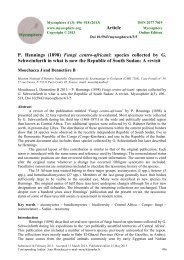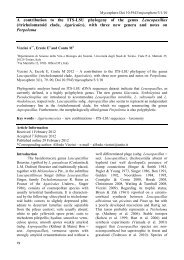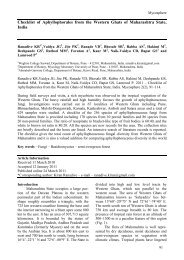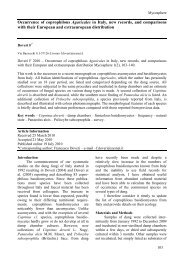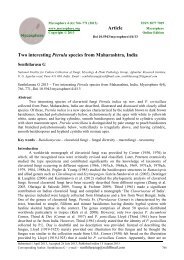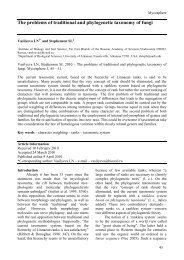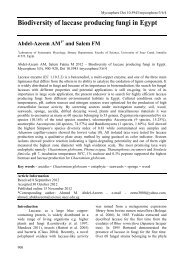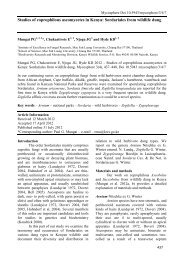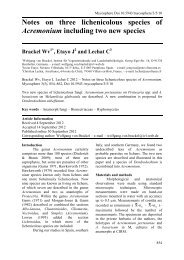Fungi Fimicoli Italici - Mycosphere-online journal
Fungi Fimicoli Italici - Mycosphere-online journal
Fungi Fimicoli Italici - Mycosphere-online journal
Create successful ePaper yourself
Turn your PDF publications into a flip-book with our unique Google optimized e-Paper software.
1999), and it has exceptionally isolated from<br />
dung (Cailleux 1971a).<br />
Rodentomyces Doveri, Pecchia, Sarrocco &<br />
Vannacci (Table 34)<br />
Refer to Doveri et al. (2010a) for the<br />
protologue of Rodentomyces gen. nov., R.<br />
reticulatus sp. nov.<br />
Sordariomycetes – Hypocreomycetidae –<br />
Melanosporales – Ceratostomataceae<br />
Melanospora Corda (Table 35)<br />
The genus Melanospora is usually<br />
isolated from decaying vegetables and soil, or<br />
detected in association with other fungi, also on<br />
dung, possibly behaving as a mycoparasite<br />
(Cannon & Hawksworth 1982). Coprophilous<br />
collections of Melanospora are unusual (Faurel<br />
& Schotter 1965, Calviello 1976, Lorenzo<br />
1990, Richardson 2004a, 2008b), and I have<br />
rarely found records of M. brevirostris (Hansen<br />
et al. 1998, Delgado Avila et al. 2001b, Moyne<br />
et Petit 2006) and M. zamiae (Seth 1968,<br />
Lorenzo 1992, Valldosera & Guarro 1992,<br />
Piontelli et al. 2006) directly from dung.<br />
Persiciospora P.F. Cannon & D. Hawksw.<br />
(Table 36)<br />
Mine and Eriksson's (2009) are the only<br />
three collections of Persiciospora known from<br />
dung, where it possibly behaves as a<br />
mycoparasite (Cannon & Hawksworth 1982).<br />
“Sordaria” minima (Table 37)<br />
“Sordaria” minima is possibly a<br />
Melanospora sp. (Lundqvist pers. comm.), but<br />
it has not been recombined yet in this genus.<br />
Like some Melanospora spp., this rare species<br />
has been found on dung in association with<br />
other fungi, particularly with Thelebolus (Lund<br />
qvist pers. comm.). Besides mine, a few other<br />
collections of S. minima have been recorded<br />
from various kinds of dung (Massee & Salmon<br />
1901, Larsen 1971, Richardson 1998, 2004b,<br />
Moyne & Petit 2006, Welt & Heine 2007).<br />
Sordariomycetes – Hypocreomycetidae –<br />
Microascales – Microascaceae<br />
Enterocarpus Locq.–Lin. (Table 38)<br />
362<br />
See the taxonomic part of this work,<br />
under Lophotrichus bartlettii, for discussion on<br />
Enterocarpus grenotii.<br />
Kernia Nieuwl. (Table 39)<br />
K. nitida is the commonest species of this<br />
genus, found by me in Italy on a variety of<br />
dungs with low frequency of occurrence in<br />
damp chambers (1%). Like other Kernia spp.<br />
and many Microascaceae with a cellulytic and<br />
proteolytic activity (Lumley et al. 2000), it has<br />
been found on a variety of substrates and<br />
dungs, particularly (24% of fimicolous records<br />
worldwide) on sheep dung (Tóth 1965, 1967,<br />
Udagawa 1980, Guarro Artigas 1983,<br />
Valldosera 1991, Richardson 2004a).<br />
Lophotrichus R.K. Benj. (Table 40)<br />
See the taxonomic part of this work,<br />
under Lophotrichus bartlettii, for discussion on<br />
Lophotrichus.<br />
Pithoascus Arx (Table 41)<br />
See the taxonomic part of this work,<br />
under Pithoascus intermedius, for discussion<br />
on Microascaceae, Pithoascus, and Microascus.<br />
Sphaeronaemella P. Karst. (Table 42)<br />
Out of five recognised species of<br />
Sphaeronaemella (Kirk et al. 2008), only one,<br />
S. fimicola, has been isolated from dung, where<br />
it can behave as a facultative mycoparasite<br />
(Cain & Weresub 1957, Weber & Webster<br />
1997, 1998). S. fimicola has a wide substrate<br />
tolerance, carnivore dung included (Marchal<br />
1891, Pease 1948, Cain 1957), but it prefers<br />
leporine (32% of several records worldwide)<br />
(Massee & Salmon 1902, Dennis 1981) and<br />
cervine (26%) (Cannon & Hawksworth 1982,<br />
Lundqvist 1989) dung.<br />
Sordariomycetes – Sordariomycetidae –<br />
Sordariales – Chaetomiaceae<br />
Chaetomidium (Zopf) Sacc. (Table 43)<br />
See the taxonomic part of this work,<br />
under Chaetomidium fimeti, for discussion on<br />
the genus Chaetomidium, C. megasporum, and<br />
C. fimeti.



